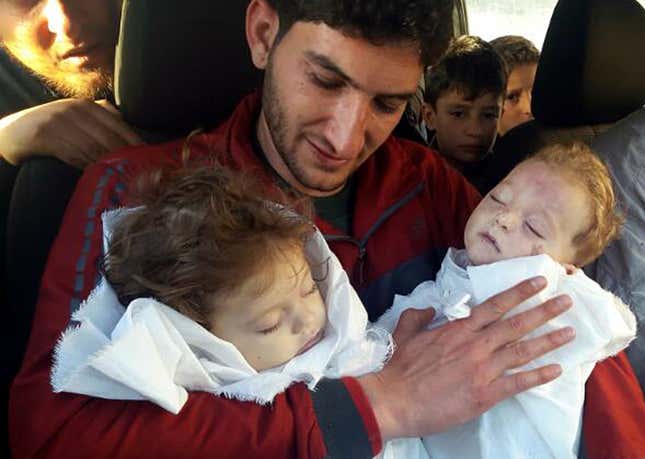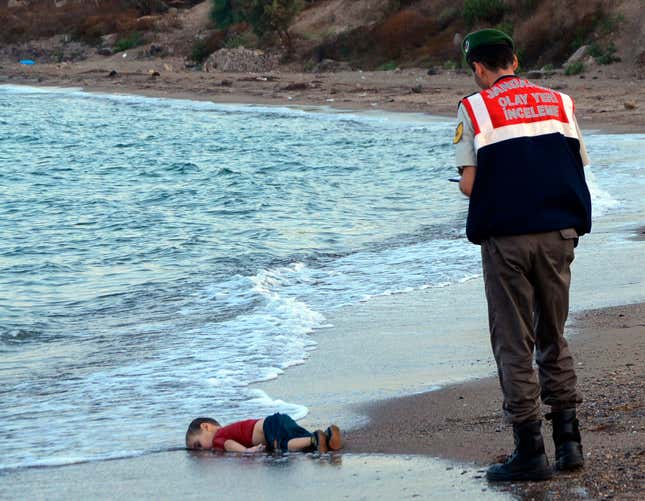Abdul-Hamid Alyousef and his 9-month-old twins, Aya and Ahmed, are the new face of the horror going on in Syria. Captured in the aftermath of a vicious chemical attack perpetrated by Bashar Al-Assad against his own people, the photo of Alyousef holding his dead babies ricocheted around the world this week. It is yet another tragic—and now viral—photo from a conflict that has claimed, according to the estimates, over 450,000 lives. But while each photo elicits gasps of sorrow and social media outrage, the death and destruction continues with little signs of slowing.

Abdul-Hamid Alyousef wanted the world to witness his tragedy. Besides his two children, Alyousef lost his wife and brother in the gas attack, and over 20 of his relatives died in the war. Presenting his dead children to a video camera, he is shown stroking their hair and asking them sweetly, as if they were alive: “Say goodbye, baby, say goodbye.”
It is a harrowing clip. The grief of this father is matched only by his courage as he holds up the two little corpses in a forceful damnation of the world’s inaction.
The message of this photo is clear: You have let this happen—you, the United States and Russia and the United Nations officials tasked with protecting human rights around the globe. The Syrian conflict is a complicated morass, but the cruelty and senselessness of Aya and Ahmed’s deaths is simple. This needs to end.
There’s also something familiar about this photo. As the war has dragged on, Syrian children have become some of the biggest champions of their people. When they die, their faces are broadcast around the world. These images shake our conscience, stirring debate and demanding action. But the cycle of violence continues, until the next face stirs our guilt once again.
In the spring of 2015, it was Hudea who tugged at the world’s heartstrings. A little refugee Syrian girl from Hama living with her mother and sister in the Atmeh refugee camp in Syria, Hudea surrendered to the lens of Turkish photographer Osman Sağırlı, mistaking his telephoto lens for a gun.
A few months later, in the summer of 2015, it was the photograph of three-year-old Aylan Kurdi that made international headlines after his lifeless was captured on the shore of the Greek island of Kos, where his family was seeking refuge. Aylan’s image launched a thousand debates and editorials, and was immortalized in cartoons around the world. His photo, we thought (and were told) was truly a turning point in this awful conflict.

But it wasn’t. And so in August of 2016, it was Omran Daqneesh’s face who stirred international anger. The little boy was photographed sitting stunned in the back of an ambulance, his tiny body covered in rubble and blood after a bombing in Aleppo. His was the picture that would surely prove to be the last straw, the media said, the one that would turn emotion into action. Except, of course, it was not.
In December 2016, seven-year-old Bana Alabed ”went viral” after she began live-tweeting the fall and destruction of Aleppo (she survived and was rescued with her family). Months after the world followed, through her words, the destruction of her city, she is still asking the world to stop being a passive spectator to her people’s annihilation.
On Apr. 5, the US ambassador to the UN Nikki Haley showed images of the children hit by the chemical attack were in an emergency UN security council meeting. By using these emotionally charged weapon, Haley hoped to compel the UN to stage a military intervention in the region. US president Donald Trump, too, once uncertain about the responsibilities of the Syrian government, said the images moved him to call the attack “an affront to humanity,” and convinced him to change his attitude towards Assad.
And yet, outrage doesn’t equal compassion. Aya, Ahmed, Hudea, Aylan, Omran, Bana, and all the others—surviving in horror, or dying, mostly, in silence—are the same children the world doesn’t want. Their parents are the refugees that populist candidates have promised to keep away, and their communities Donald Trump labels as breeding grounds for terrorists.
Moved as he may be by the beautiful little babies” who died in yesterday’s attack, or by Ivanka Trump’s heartbreak and outrage over the latest batch images coming out of Syria, he doesn’t seem to reconsider that, perhaps, the US could offer them shelter. And so, while the images of the chemical attack may have ultimately moved Trump to order a military strike against Assad’s regime, intervention still doesn’t make up for the solidarity that the watching world should have shown too many children ago.
